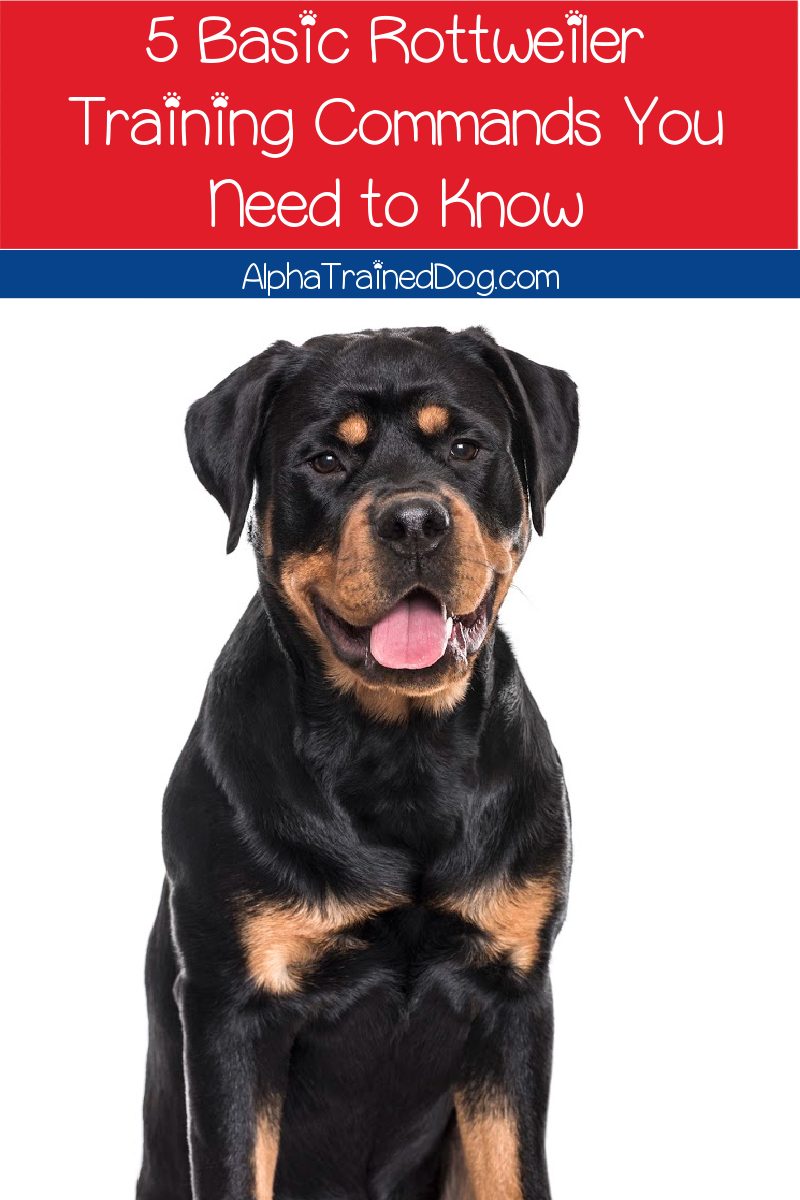It’s important to know basic Rottweiler training commands if you own one of these big boys.
Rottweilers are a good-natured breed, and they make excellent family pets.
However, as strong dogs with a reputation (albeit unearned), they need a strong training foundation.
Read on for the very basic commands to teach them right away.

Basic Rottweiler Training Commands You Need to Know
That being said this is a large, powerful breed, and if not socialized and trained properly, they can present a hazard to other people and animals.
That’s not to say that Rottweilers are inherently aggressive.
The need for socialization and training is paramount with any breed that is so large and powerful.
With big breeds like this, the greatest danger often lies in accidental injuries due to the dog not knowing his own strength.
That’s why today, we’re talking about basic Rottweiler training commands and how they can help you raise a well-behaved, gentle giant.
Why Basic Rottweiler Training Commands are so Important

As I said, Rottweilers make excellent family dogs.
This is a breed you certainly can’t judge by its cover.
One of the oldest dog breeds in the world, Rottweilers were bred for power, their large, muscular frames used for guarding Roman outposts, driving cattle, and hauling heavy loads.
Rotts are also highly independent and will take action on their own if they deem it necessary.
This combination of size, power, energy, and independent thinking makes it imperative that owners give their Rotts structure and plenty of exercise from the very beginning.
Being bred for guarding and herding, you might imagine that the Rottweiler is a standoffish breed, and his looks often leave some fearing that he’s a downright killer, but none of these are accurate.
The rugged exterior of the Rott that is so scary to some belies a heart of pure gold.
Rottweilers are naturally playful, even silly, dogs that adore their family.
This is a big dog who mistakes himself for a laptop, commonly flopping onto his family members for a cuddle that is full of love AND poundage.
In addition, Rottweilers are actually very good with kids and other dogs, making them an even more attractive breed for a family.
So what does all of this mean? It means that basic Rottweiler training commands are critical to raising a well-behaved Rottie.
This large, powerful dog has an inborn instinct to guard and will act on it if he feels that his family is in danger.
In addition, a particularly friendly, particularly excited Rott can cause injury simply by tackling a small child, jumping on an older person, or playing too rough with another dog.
Basic training is the first step to avoid any of these outcomes.
When to Start Basic Obedience Training
Basic obedience training can begin as early as six weeks of age.
Like children, puppies are sponges, and they readily soak up basic ideas and concepts.
This makes it the perfect time to begin light training in basic commands and building on those as your puppy grows.
At such a young age, it’s important to remember that your Rott’s attention span will be limited, so don’t try to do too much at once.
Keep training sessions short, beginning at about 5 minutes or less if your pup loses focus.
As he gets older, his ability to stay focused through longer sessions will increase.
Allow him to lead the session when it comes to length.
Training too long is counterproductive and only results in frustration for both you and your dog.
What You Need for Basic Obedience Training

You don’t need much to begin basic obedience commands to your Rott.
Basic Rottweiler commands can be taught with very little equipment. You’ll need:
- A space free of distractions
- Reward system: treats, kibble, a favorite toy
- Lots of patience
That’s it. It doesn’t take much to begin basic obedience training. Remember to bring that patience with you. It’s a key part of training any dog.
Basic Rottweiler Training Commands
And here we are. We know why it’s important to teach these commands.
Now, all that’s left is to give you the basics.
These commands help stimulate your dog’s mind.
They also give him a good foundation for more advanced training later, whether it be learning to roll over, play dead, or do agility courses.
By teaching these commands now, you’ll cement in your dog’s mind that he should always look to you for direction and reward.
1. Sit
Sit is the first one to teach in our list of basic Rottweiler training commands. Other commands will build on this foundation.
Get your Rott’s attention and hold a treat just in front of his nose.
Begin moving the treat above his head and back toward his hind end.
He’ll naturally sit while his nose follows the treat.
Give the sit command as his rump hits the floor and then give him praise and the treat.
Repeat this process until he only needs the sit command to perform the action.
2. Shake
Next is shake. Tell your dog to sit, then say “shake” in an upbeat voice while picking up one of his paws.
When his paw is in your hand, give him lots of praise and a treat.
Repeat this process until he gives you his paw whenever you say “shake”.
This is an excellent command to teach because it gets your dog used to having his paws touched, which is a big help in grooming.
.3. Lay Down
Give your dog the sit command. While he’s in the seated position, calmly give the “lay down” command.
As you give the command, slide his paws forward until he’s laying down. While he’s laying down, give him lots of calm praise and a treat.
Repeat this process until he can perform the command on his own.
This command is important because it will help you calm him down if he gets too rambunctious or if you want him to be calm in a new situation.
4. Stay
Up next on our list of basic Rottweiler training commands is “stay”.
Ask your dog to sit or lay down, then give them the stay command in a calm, firm voice.
After you give the command, back away slowly. Begin with a very short distance and a very short time.
Back away about a foot and stay there for a couple of seconds, then move back toward your pup.
If he doesn’t move the entire time, give him praise and a treat.
This one takes a lot of practice and patience because your Rott will naturally want to move to where you are.
Practice patience and consistency, and only reward him after you’ve moved away and come back to where you started.
Stay is an important command because it helps you control your dog in situations where you don’t necessarily want him running around.
5. Come
After your pooch has mastered sit and stay, it’s time to move on to “come”.
Give your dog the sit and stay commands and move away a few feet.
Say “come” in a friendly, enthusiastic voice. If your dog doesn’t immediately come to you, that’s okay. He’s still in “stay” mode.
That’s good. It means he’s mastered the command.
Give the come command again even more enthusiastically, bending over and clapping or otherwise engaging your pup if necessary.
When he comes to you, reward him with lots of praise and a treat. Repeat this process until your dog reliably comes to you from the sit/stay position with only the command.
This command is important because it can help you keep your dog from running off if he somehow gets off his leash or out of the fence.
When he hears the command, he should immediately come back to you if he’s been trained properly.
Lean Basic Rottweiler Training Commands to Raise the Goodest Boi
Basic Rottweiler training commands will help you enhance all the good things about your Rott and minimize any potentially bad things.
In this case, bad simply means being out of control or overly exuberant.
When you teach basic Rottweiler training commands, you’ll raise a well-behaved dog who looks to you for guidance and is less likely to make potentially bad decisions on his own.
Good luck with your training!

